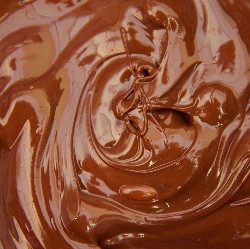Chemistry researchers at University of Warwick in the U.K. developed a process for keeping the desirable taste and texture of chocolate while sharply reducing its fat content. Warwick’s Stefan A. F. Bon described the process yesterday in a presentation at a meeting of the American Chemical Society in New Orleans.
Bon and colleagues study colloidal systems, where microscopic particles of one substance are dispersed through other substances, especially where particles can be synthesized to trigger and control their movement or assembly. Bon’s Lab at Warwick in particular works on technologies with industrial and commercial applications, including food products.
In addition to its appealing taste and texture, some chocolate is high in antioxidants that protect the body against damaging free radicals. But chocolate is also high in fat and sugar. A 2-ounce serving of chocolate can contain as much as 13 grams of fat, or 20 percent of the recommended total fat content, particularly unsaturated fat.
The process developed by Bon and colleagues uses a technique called a Pickering emulsion, named for its discoverer more than a century ago, that stabilizes ingredients in an emulsion that would otherwise not mix together. Mayonnaise, for example, is a Pickering emulsion of egg yolk and oil. Chocolate is also an emulsion, of cocoa butter and water or milk combined with cocoa powder and an emulsifier, usually lecithin.
The Warwick process removes the emulsifier from the chocolate and replaces it with fine droplets from fruit juice spread out through the chocolate in a Pickering emulsion. Bon notes that “Since the juice is spread out in the chocolate, it doesn’t overpower the taste of the chocolate,” and adds, “The opportunity to replace part of the fat matrix with water-based juice droplets allows for greater flexibility and tailoring of both the overall fat and sugar content.”
The researchers say they have used this process with dark, milk, and white chocolate, and made chocolate infused with apple, orange, and cranberry juice. In addition to fruit juice, the process also works with vitamin C-enhanced water and diet soda. “We have established the chemistry that’s a starting point for healthier chocolate confectionary,” says Bon. “Now we’re hoping the food industry will take the next steps and use the technology to make tasty, lower-fat chocolate bars and other candy.”
Read more:
- New International Food Allergy Management Study Underway
- Symbols and Calorie Labels Influence Restaurant Choices
- Omega-3 Fatty Acids Added to Milk Without Affecting Taste
- New Potato Type Bred for Higher Carotenoid Levels
- Color Codes, Eye-Level Positions Boost Healthy Food Choices
* * *


 RSS - Posts
RSS - Posts
You must be logged in to post a comment.